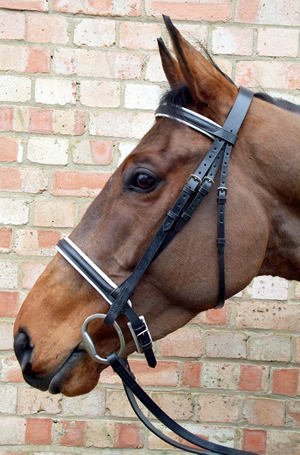
By Dr. Jim & Lynda McCall in The American Quarter Horse Journal, September 21, 2010
The Problem
I have been riding my 2-year-old gelding for about three months, but I still can’t seem to get him responsive to the bit. I had his wolf teeth removed before placing the bit in his mouth, so I’m sure that isn’t the problem.
Each time I pull on the reins, the colt gaps or opens his mouth. Of course, with his mouth open, the action of the bit is reduced, and I have less control over the young horse.
Why won’t this colt accept the bit, and what can I do to correct this problem?
The McCalls’ Answer
By opening his mouth, this horse is trying to escape from the pressure of the bit. The first step to fixing the problem begins with an understanding of why the colt is trying to reject the bit.
A wise trainer once said, “Training horses is not difficult. They are quite willing to perform any task they are capable of, so long as it does not cause them immediate pain.” We totally agree with this idea, so the search for a solution must begin with an examination of the mouth to be sure the bit is not the culprit.
Fortunately, this rider answered our first question: “Have the wolf teeth been removed?” It is nearly impossible to successfully ride any horse in a bit if he has not had these teeth removed.
Since we’ve eliminated the possibility of the bit grating on the wolf teeth, the rider should consider the bit itself. Young horses do not instinctively understand what bit pressure means. Many times, the first response is to try to escape from the pressure by pushing through the discomfort created by the bit. Too often, this results in the rider pulling back even harder on the reins, which places extreme force on the jaw bone. To escape, the horse opens his mouth – yielding his lower jaw but driving forward with his head and neck.
To transform this preliminary training into a positive experience, the rider needs to go back to Step 1: The introduction of the bit as a control for the movement of the horse. The horse should think of the bit as a piece of equipment worthy of respect, but not fear it as something to be rejected.
The first bit used in a horse’s mouth should be mild enough not to elicit fear from the naive youngster. A smooth snaffle, wide-bar snaffle, rubber-covered snaffle or a snaffle with more than one break in the mouthpiece are good bits for the uneducated mouth.
Not every bit will work on every horse. Some young horses are so tender-mouthed that the rubber-covered snaffle is almost too harsh. This rider needs to search for a soft bit that fits the mouth of the colt he is breaking.
The bit is a line of communication between the horse’s head and the hands of the rider. Therefore, the bit must also fit the hands of the rider. A rider with strong hands needs to go to a milder bit; a rider who has lighter hands may need to compensate by using a bit with more feel to it – perhaps like a twisted-wire snaffle.
Assuming that this rider has the right bit, it is time to teach the horse the correct response to the bit’s presence and use. We normally start this process by letting a naïve horse wear the bit (without the reins attached) in the stall or when working in the round pen.
After this non-threatening presentation, there are several choices that lead the horse to understand bit pressure: the use of a bitting rig, ground-driving or riding in a small pen when the rider can introduce the bit through a series of mild tugs and pulls; or riding in a rope noseband with a second set of reins going to the bit.
The key to the correct choice is that the horse gains some understanding of what is expected from him when the bit is engaged: He is supposed to give to the pressure either by turning or flexing at the poll.
Still, after all this has been done, this horse might still want to reject the bit. At this point, it may be time to restrict the colt’s option to commit this infraction. The tools most often chosen are the cavesson and the dropped nose band.
The caveson is belted around the horse’s muzzle above the bit and below the jowl in a position that allows for some hinged jaw movement. The dropped nose band fits on the muzzle below the bit and is, usually, more restrictive to the horse opening his mouth. (Care should be taken not to draw the dropped nose band too tight, as it can restrict the flow of air to the nostrils.)
The object of using either of these devices is to teach the horse that he cannot drop his jaw to escape from the pull of the bit. Once this lesson is learned, the additional headgear should be removed. Under no circumstances should these pieces of equipment be regarded as a means to force the horse to accept too harsh a bit or be used to compensate for a rider’s poor hands.
A horse’s mouth is an extremely sensitive structure. Treat it with respect, and the rewards of riding a truly responsive horse will be yours.
